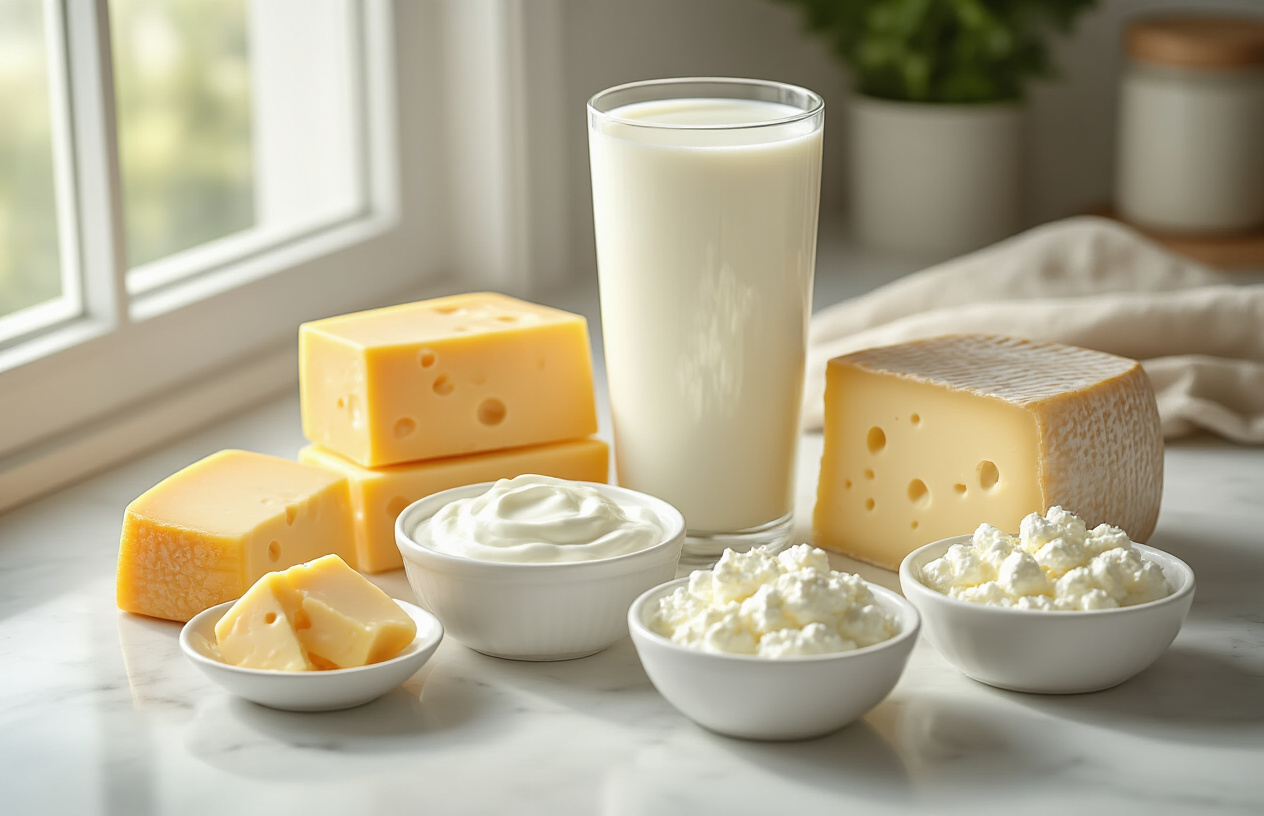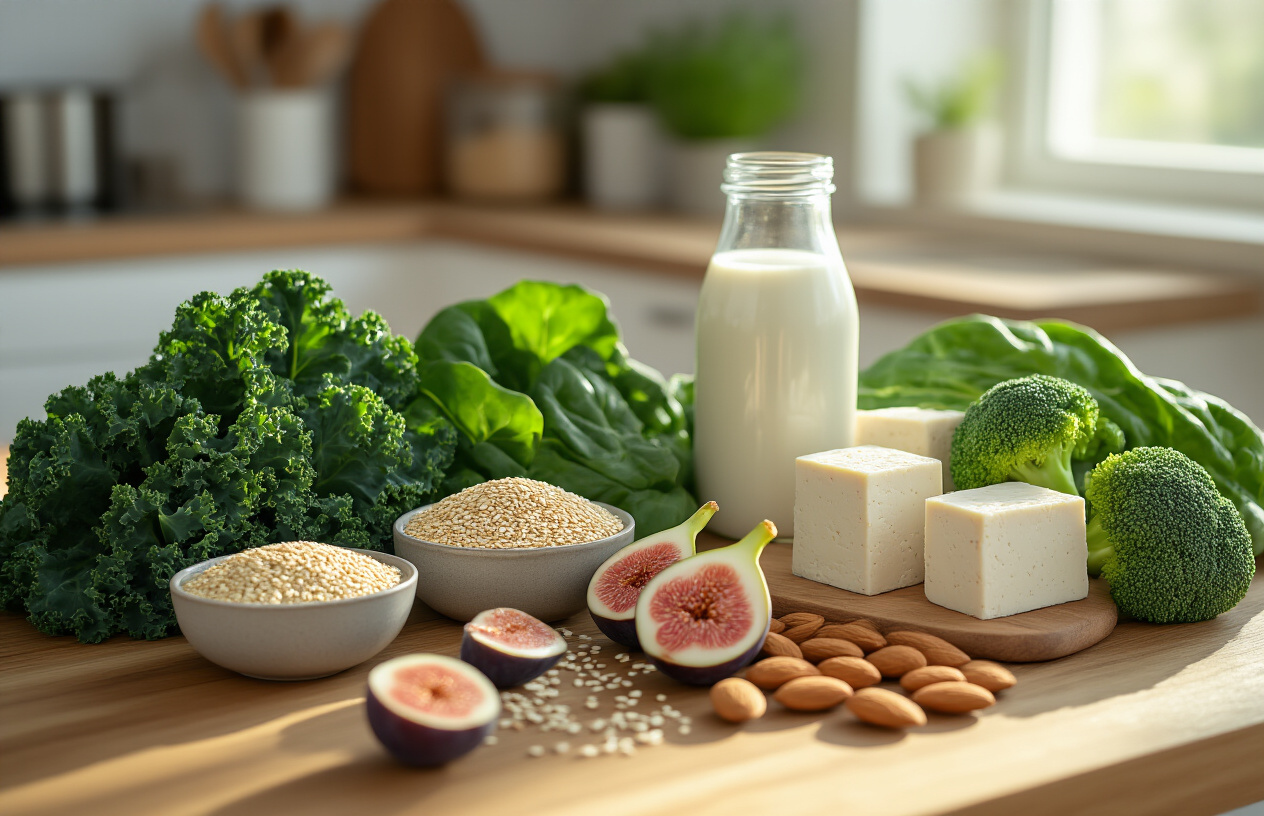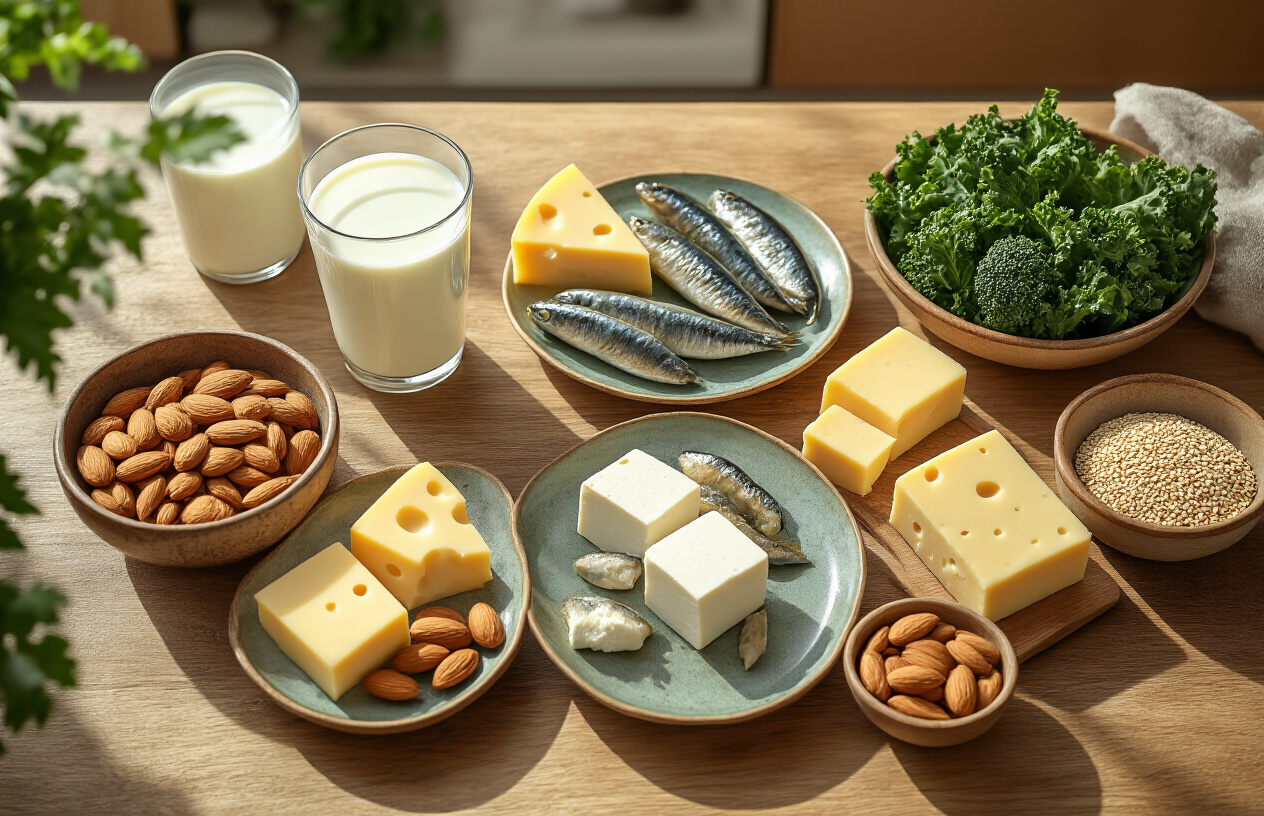Calcium keeps your bones strong, your muscles working, and your heart beating steadily. This guide is for anyone wanting to boost their calcium intake through smart food choices – from busy parents planning family meals to athletes looking to support their training.
We’ll explore the best high-calcium foods across different categories so you can find options that fit your lifestyle. You’ll discover top dairy sources that your body absorbs easily, plus plant-based alternatives that pack a serious calcium punch for vegetarians and vegans. We’ll also share simple tips to help your body actually use the calcium you’re eating, so you get the most benefit from every bite.
Why Your Body Needs Calcium for Optimal Health

Strengthens bones and prevents osteoporosis
Your bones aren’t just static structures holding you upright – they’re living tissue that constantly rebuilds itself. Calcium serves as the primary building block for this ongoing renovation project. When you don’t get enough calcium, your body starts mining it from your bones, leaving them weaker and more porous over time.
About 99% of your body’s calcium lives in your bones and teeth, creating the mineral matrix that gives them strength and structure. During childhood and adolescence, calcium helps bones grow longer and denser. After age 30, bone formation slows down, making adequate calcium intake even more critical to prevent bone loss.
Osteoporosis affects over 10 million Americans, with another 44 million having low bone density. Women face higher risk after menopause when estrogen levels drop, accelerating bone loss. Men aren’t immune either – they typically experience gradual bone density decline starting around age 50.
Supports proper muscle function and contraction
Every time you move – whether you’re lifting weights, typing, or simply blinking – calcium makes it happen. This essential mineral acts like a molecular switch, triggering muscle contractions when your nervous system sends signals.
When a nerve impulse reaches your muscle, calcium ions flood out of storage sites within muscle cells. These calcium ions bind to specific proteins, causing muscle fibers to contract. Once the signal stops, calcium gets pumped back into storage, allowing the muscle to relax.
Without adequate calcium levels, muscles can’t contract properly. You might experience muscle cramps, spasms, or weakness. Your heart muscle also depends on calcium for its rhythmic contractions – irregular heartbeats can result from calcium imbalances.
Enables healthy blood clotting mechanisms
Blood clotting might not cross your mind until you get a cut, but this complex process saves your life countless times. Calcium plays a starring role in the clotting cascade – a series of chemical reactions that stop bleeding.
When blood vessels get damaged, platelets rush to the scene and stick together. Calcium helps activate several clotting factors, proteins that work together like dominoes falling in sequence. Each step depends on calcium to trigger the next reaction, ultimately forming fibrin threads that weave together into a stable blood clot.
People with calcium deficiencies may experience excessive bleeding from minor cuts or bruising more easily than normal. This happens because their blood can’t clot efficiently without adequate calcium levels.
Maintains cardiovascular health and blood pressure
Your heart and blood vessels rely on calcium for proper function, but the relationship is more nuanced than you might expect. Calcium helps heart muscle cells contract with each heartbeat, pumping blood throughout your body.
Research shows that getting enough calcium from food sources may help lower blood pressure, especially in people who are salt-sensitive. Calcium appears to help blood vessel walls relax and contract normally, supporting healthy circulation.
The key lies in balance – while calcium deficiency can contribute to high blood pressure, too much calcium from supplements might cause problems. Your body absorbs calcium from food more efficiently than from pills, making dietary sources the preferred choice for cardiovascular health.
Calcium also works alongside magnesium and potassium to regulate heart rhythm and blood vessel function. This mineral trio helps maintain the electrical activity that keeps your heart beating steadily.
Top Dairy Sources Rich in Bioavailable Calcium

Milk varieties and their calcium content per serving
Whole milk delivers about 280-300mg of calcium per 8-ounce glass, making it one of the most reliable calcium sources you can find. The fat content doesn’t significantly impact calcium levels, so whether you choose whole, 2%, 1%, or skim milk, you’re getting roughly the same calcium bang for your buck.
Lactose-free milk matches regular milk’s calcium content since the lactose removal process doesn’t affect mineral levels. Many brands even fortify their lactose-free versions with extra calcium, sometimes reaching 350mg per serving.
Plant-based milk alternatives vary wildly in calcium content. Fortified almond, soy, and oat milks can contain 300-450mg per cup when calcium carbonate is added, but always check labels since unfortified versions contain minimal calcium.
Raw milk contains similar calcium levels to pasteurized milk, though the bioavailability might differ slightly due to enzyme content. Goat milk provides comparable calcium to cow’s milk at around 327mg per cup, plus it’s easier to digest for some people.
Cheese options that maximize calcium intake
Hard cheeses pack the biggest calcium punch. Parmesan cheese tops the charts with approximately 390mg of calcium per ounce – that’s more calcium than a glass of milk in just one serving. Romano, aged cheddar, and Gruyère follow closely behind with 300-350mg per ounce.
| Cheese Type | Calcium per ounce | Best for |
|---|---|---|
| Parmesan | 390mg | Grating, snacking |
| Romano | 350mg | Pasta dishes |
| Aged Cheddar | 340mg | Sandwiches, melting |
| Swiss | 270mg | Cooking, eating |
| Mozzarella | 220mg | Pizza, salads |
Processed cheeses like American cheese contain about 200mg per ounce, while soft cheeses such as brie and camembert provide around 150mg per ounce. The aging process concentrates calcium as moisture evaporates, which explains why aged cheeses contain more calcium than their younger counterparts.
Ricotta cheese deserves special mention with 335mg of calcium per half-cup serving. Its creamy texture makes it perfect for both sweet and savory dishes, from lasagna to pancakes.
Yogurt benefits for calcium absorption
Greek yogurt contains 200-250mg of calcium per 6-ounce serving, while regular yogurt provides slightly more at 300-400mg per cup. The straining process that creates Greek yogurt removes some calcium along with the whey, but the higher protein content may help your body absorb the remaining calcium more effectively.
The live cultures in yogurt create an acidic environment in your digestive tract, which helps dissolve calcium and makes it easier for your body to absorb. Lactobacillus and Bifidobacterium strains specifically support calcium uptake by producing organic acids that keep calcium in its soluble form.
Yogurt’s protein content also plays a crucial role in calcium absorption. The amino acids, particularly lysine and arginine, help transport calcium across intestinal walls. This protein-calcium combination makes yogurt one of the most bioavailable calcium sources available.
Choose plain yogurt over flavored versions when possible. Added sugars can interfere with calcium absorption, and many flavored yogurts contain less actual yogurt per serving due to added ingredients. If you need sweetness, add fresh fruit or a drizzle of honey instead of buying pre-sweetened varieties.
Frozen yogurt contains less calcium than regular yogurt since it’s diluted with other ingredients, typically providing 100-150mg per half-cup serving.
Plant-Based Calcium Powerhouses for Every Diet

Dark leafy greens that outperform dairy
Several dark leafy greens actually contain more absorbable calcium per serving than traditional dairy products. Collard greens lead the pack with 357 mg of calcium per cooked cup, while kale provides 179 mg. What makes these greens exceptional is their calcium absorption rate of 40-64%, compared to milk’s 32%.
Bok choy offers 158 mg per cup with excellent bioavailability, making it perfect for stir-fries and soups. Turnip greens deliver 249 mg per cooked cup, while mustard greens provide 165 mg. The key advantage lies in these greens’ low oxalate content, which doesn’t interfere with calcium absorption like spinach does.
| Green Vegetable | Calcium (mg per cup) | Absorption Rate |
|---|---|---|
| Collard Greens | 357 | 50-60% |
| Turnip Greens | 249 | 40-50% |
| Kale | 179 | 40-59% |
| Bok Choy | 158 | 50-60% |
Nuts and seeds with impressive calcium levels
Almonds stand out as calcium champions among nuts, providing 246 mg per quarter cup. Just 23 almonds deliver about 25% of your daily calcium needs. Almond butter offers convenience with 111 mg per 2-tablespoon serving.
Sesame seeds pack an incredible calcium punch at 351 mg per quarter cup. Tahini, made from ground sesame seeds, contains 154 mg per 2 tablespoons, making it an excellent spread for toast or ingredient in dressings. Poppy seeds provide 503 mg per quarter cup, though they’re typically used in smaller amounts.
Brazil nuts contribute 45 mg per ounce, while hazelnuts offer 32 mg. Seeds like sunflower (22 mg per ounce) and pumpkin seeds (12 mg per ounce) add moderate amounts but combine well with other calcium sources.
Fortified plant milks and their absorption rates
Plant-based milk alternatives often contain more calcium than dairy milk through fortification. Most brands add calcium carbonate or tricalcium phosphate, bringing levels to 300-450 mg per cup. Soy milk typically absorbs as well as cow’s milk, with rates around 75% when fortified with calcium carbonate.
Almond milk varies widely between brands, ranging from 200-450 mg per cup. Oat milk generally provides 350-400 mg when fortified. Rice milk offers similar levels but has lower protein content. Always shake these products well, as calcium settles at the bottom.
The absorption from fortified plant milks depends on the calcium salt used. Calcium carbonate requires stomach acid for absorption, while calcium citrate absorbs better on an empty stomach. Look for products with added vitamin D, which enhances calcium uptake.
Legumes and beans for sustained calcium intake
White beans top the legume category with 191 mg of calcium per cup, making them excellent additions to soups and salads. Navy beans provide 126 mg, while chickpeas offer 80 mg per cup. These foods release calcium slowly, supporting steady blood levels throughout the day.
Tofu made with calcium sulfate delivers 253-861 mg per half cup, depending on firmness and preparation method. Tempeh provides 184 mg per cup, along with probiotics that may improve calcium absorption.
Black-eyed peas contribute 185 mg per cup, while soybeans offer 175 mg. Lentils provide moderate amounts at 37 mg per cup but combine excellently with other calcium sources in mixed dishes. The fiber in legumes slows calcium release, preventing absorption interference that can occur with large calcium doses taken at once.
Seafood and Fish That Boost Your Calcium Levels

Canned fish with edible bones for maximum benefit
Canned salmon and sardines pack the biggest calcium punch in the seafood world. The secret lies in their soft, edible bones that become perfectly tender during the canning process. A 3.75-ounce can of sardines delivers around 350-400 mg of calcium – roughly one-third of your daily needs. Canned salmon with bones provides about 180-200 mg per 3-ounce serving.
The bones in these canned fish are so soft you barely notice them, making them an easy way to boost calcium intake without any unpleasant texture. Pink salmon tends to have more calcium than red salmon because it contains more small bones. When shopping, always choose canned fish labeled “with bones” rather than boneless varieties to maximize your calcium benefits.
Canned mackerel also deserves attention, offering approximately 250 mg of calcium per 100-gram serving. These fish work perfectly in salads, pasta dishes, or eaten straight from the can with crackers. The convenience factor makes them ideal for busy schedules while delivering exceptional nutritional value.
Fresh fish varieties with notable calcium content
While fresh fish generally contains less calcium than their canned counterparts with bones, several varieties still contribute meaningful amounts to your daily intake. Rainbow trout leads the pack among fresh fish, providing about 80-90 mg of calcium per 3-ounce serving. This makes it an excellent choice for those who prefer fresh fish over canned options.
Anchovies, whether fresh or packed in oil, deliver impressive calcium levels at roughly 150 mg per ounce. Their intense flavor means a little goes a long way in dishes like Caesar salads, pizza, or Mediterranean pasta sauces.
Ocean perch offers around 60 mg of calcium per 3-ounce serving, while herring provides approximately 50 mg. Even salmon fillets without bones contribute about 15-20 mg per serving, though significantly less than canned versions. Smelt, a small fish often eaten whole, provides excellent calcium since you consume the entire fish, including tiny bones.
Shellfish options for diverse calcium sources
Shellfish bring variety and impressive calcium content to your plate. Shrimp leads the category with about 60-70 mg of calcium per 3-ounce serving, making it both delicious and nutritious. The calcium comes primarily from the exoskeleton, which explains why whole small shrimp provide more calcium than large, peeled varieties.
Crab meat contains approximately 50 mg of calcium per 3-ounce serving, with soft-shell crab offering even more since you eat the entire shell. Lobster provides around 50-60 mg per serving, while scallops contribute about 30 mg.
Oysters deserve special mention, delivering roughly 40 mg of calcium per 3-ounce serving along with other essential minerals. Mussels provide similar amounts and work wonderfully in soups, pasta dishes, or steamed preparations.
| Shellfish Type | Calcium Content (per 3 oz) |
|---|---|
| Shrimp | 60-70 mg |
| Crab | 50 mg |
| Lobster | 50-60 mg |
| Oysters | 40 mg |
| Mussels | 40 mg |
| Scallops | 30 mg |
These shellfish options offer flexibility in meal planning while contributing to your overall calcium goals. They pair beautifully with calcium-rich vegetables and can be prepared in countless ways to keep your meals interesting and nutritious.
Maximizing Calcium Absorption for Better Results

Vitamin D partnership for enhanced uptake
Calcium and vitamin D work together like best friends – one can’t do their job properly without the other. Your body absorbs only about 10-15% of dietary calcium without adequate vitamin D, but this jumps to 30-40% when vitamin D levels are optimal. This sunshine vitamin activates calcium transport proteins in your intestines, essentially opening the door for calcium to enter your bloodstream.
The sweet spot for vitamin D is between 30-50 ng/mL in your blood. You can boost your levels through 15-20 minutes of daily sun exposure, fatty fish like salmon and mackerel, or quality supplements. Many people don’t realize that taking calcium supplements without vitamin D is like trying to fill a bucket with holes in it – most of the calcium just passes through your system unused.
Foods that block calcium absorption to avoid
Several common foods and compounds can significantly reduce your body’s ability to absorb calcium. Oxalates, found in spinach, rhubarb, and beet greens, bind to calcium and prevent absorption. While these foods offer other nutritional benefits, don’t rely on them as your primary calcium sources.
Phytic acid in whole grains, beans, and nuts can also interfere with calcium absorption. Soaking, sprouting, or fermenting these foods helps break down phytic acid. Excessive sodium pulls calcium from your bones and increases urinary calcium loss – aim for less than 2,300mg of sodium daily.
| Absorption Inhibitors | Found In | Impact Level |
|---|---|---|
| Oxalates | Spinach, rhubarb, chocolate | High |
| Phytic acid | Whole grains, legumes | Moderate |
| Caffeine | Coffee, tea, sodas | Mild |
| Excess sodium | Processed foods | High |
| Alcohol | Wine, beer, spirits | Moderate |
Optimal timing strategies for calcium consumption
Your body can only absorb about 500-600mg of calcium at once, so spreading intake throughout the day works better than taking large amounts in single doses. Taking calcium with meals improves absorption because stomach acid helps break it down. The acid produced during digestion creates an environment where calcium dissolves more easily.
Avoid taking calcium supplements with iron supplements or high-iron foods, as these minerals compete for absorption. Space them at least two hours apart. Evening calcium intake can be particularly beneficial since bone remodeling peaks during sleep, and your body naturally loses calcium through urine overnight.
Magnesium balance for improved bone health
Magnesium plays a crucial supporting role in calcium metabolism – about 60% of your body’s magnesium is stored in bones alongside calcium. This mineral activates vitamin D, helps regulate calcium transport, and supports the enzymes that build bone tissue. The ideal calcium-to-magnesium ratio is roughly 2:1, though some experts suggest closer to 1:1.
Signs you might need more magnesium include muscle cramps, restless sleep, or chocolate cravings. Good magnesium sources include dark leafy greens, nuts, seeds, and whole grains. Taking calcium without adequate magnesium can actually worsen magnesium deficiency and lead to muscle tension, irregular heartbeat, and poor sleep quality.

Getting enough calcium doesn’t have to be complicated. From traditional dairy favorites like milk and cheese to surprising plant-based options like leafy greens and fortified foods, there are plenty of delicious ways to meet your daily needs. Even seafood lovers can boost their intake with sardines and canned salmon with bones. The key is knowing which foods pack the biggest calcium punch and how to help your body absorb it better.
Your bones and muscles depend on consistent calcium intake throughout your life, not just during childhood. Start small by adding one calcium-rich food to each meal, whether it’s sprinkling sesame seeds on your salad or enjoying a glass of fortified plant milk with breakfast. Remember to pair these foods with vitamin D and magnesium when possible, and spread your calcium intake throughout the day for maximum absorption. Your future self will thank you for building these healthy habits now.













